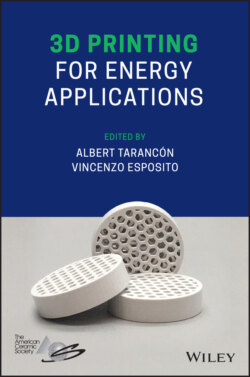Читать книгу 3D Printing for Energy Applications - Группа авторов - Страница 13
I.2 3D Printing Hierarchical, Material and Functional Complexity
ОглавлениеAll types of industry will benefit from the introduction of complex geometries generated by additive manufacturing but it will be even more interesting to take advantage of other unique capabilities of additive manufacturing, such as hierarchical, material of functional complexity [7].
The hierarchical complexity involves the fabrication of features with shape complexity across multiple size scales. This multiscale approach can cover up to five orders of magnitude for some of the available 3D printing techniques. For instance, SLA printing scale ranges from tens of micrometres to almost one meter, which allows including small details in high aspect ratio printed parts. This feature is extremely relevant for many applications like energy where the performance of devices is typically proportional to the active area such as in chemical reactors or electrochemical cells.
A high level of material complexity can also be introduced in printed pieces by processing in a different way at different points of the part, for example, introducing different levels of porosity all along the object by changing the laser parameters in SLA or the gray level in inkjet printing. This material complexity can also refer to a more advanced multi‐material printing. This has been traditionally employed in inkjet implementing a matrix of printheads for colorful printing but it is still under development for other types of technologies. This approach allows the deposition of different materials or, eventually, materials of different nature in a single process. The multi‐material capability enables the fabrication of graded compositions or, ultimately, complete devices. Independently on the printing deposition technique, one of the unsolved critical issues in processing of multi‐material parts is the quality of the interfaces between dissimilar materials [8, 9]. This represents one of the most interesting fields of current research on 3D printing.
Finally, 3D printing is able to lend a high level of functional complexity to the parts by design or by direct implementation of functional materials. By design, one can easily imagine the fabrication of specific shapes with certain functionality such as plasmonic patterns or cantilevers for energy harvesting as well as the deposition of thin layers acting as antireflective or water‐proof coatings for photovoltaics. By using functional materials, the conceptual design of 3D printed parts with high level of functional complexity is even more straightforward since the printed material has specific functionalities by itself. Despite the enormous potential of this approach, its implementation is very much limited by the short list of available advanced materials for printing uses [8]. Just to give an example of the low availability of printable functional materials, Table I.1 shows a comprehensive compilation of most of the advanced oxides reported so far (beyond structural materials or bioceramics).
Table I.1 Functional ceramics processed in the past with additive manufacturing technologies
Source: Based on Mueller et al. [8]. © 2017 John Wiley & Sons.
| AM technique | Inkjet | SLS | SLA | FDM | LOM |
|---|---|---|---|---|---|
| Functional ceramic | BaTiO3 PZT TiO2 LSMO/YBCO YSZ/CGO SDC/SSC BaTiO3 [10] BaTiO3/P(VDF‐TrFE) [11] ZnO ink [12] | PZTBaTiO3 SiCN YSZ | PZTFe2O3/Fe(C2O4) SiCN BaTiO3/photo‐resin [2] PZT@Ag/photo‐resin [13] ZnO/photo‐resin [14] YSZ [15, 16] | BaTiO3 PZT, PMN LiFePO4/Li4Ti5O12 BaZrO3, SrTiO3 BaMn2Al10O19−x ITO, ZnO La(Mg0.5, Ti0.5)O3 Zr0.8Sn0.2TiO4 TiO2 BaTiO3/PVA paste [15] | SiO2‐Al2O3‐RO‐glass LZSA‐Glass PZT |
This migration from structural to functional materials will result in the fabrication of advanced devices with high value added, which will extend the markets where 3D printing is applied from prototyping to manufacturing. Up to now, most of the 3D printing techniques have been developed and commercialized for the fabrication of polymeric and metallic structural parts but recently the focus has moved to the production of functional‐quality components made of advanced materials including, for instance, composites, ceramics, and nanomaterials.
In the case of composites, enhanced properties are expected from the fabrication of complex shapes using inorganic‐polymer matrix based materials [8]. The most evident application is probably the printing of fibre‐reinforced polymeric composites for improving mechanical properties of structural parts [17] but also other applications in which the inorganic loading has functional properties are envisaged, for example, 3D‐printed dielectric/plastic composites [18]. Beyond polymer‐based materials, it is of great interest the printing of metal–ceramic or ceramic–ceramic composites since they can have a strong impact in strategic fields such as electronics or energy [19].
The relevance of the recent progress on 3D printing of ceramics lies in the broadest spectrum of functional properties of this type of materials compared to all other classes, such as metals or polymers. The unique functional properties of advanced ceramics (electrical, optical, or magnetic) make them of critical importance to face upcoming technological challenges especially in the fields of electronics, information and communication technologies (ICT), and energy and environment. In this regard, recent advances in printing piezoelectric materials [20], dielectrics [21] or ionic conductors [22, 23] represent the beginning of a big revolution.
The use of nanomaterials for 3D printing will also bring interesting advantages, especially if they are functional nanomaterials, because they will enable the increase of complexity in shape (fine surface finishing, high vertical resolution, or improved layer assembly), hierarchy (multi‐length‐scale structures or graded porosity), materials (low sintering temperature in ceramics and metals or multi‐material deposition in suspension), and functionality (use of nanocomposites or nanomaterials with high surface area or core‐shell structures).
